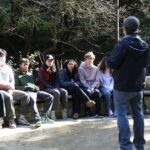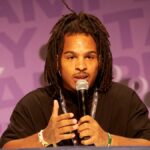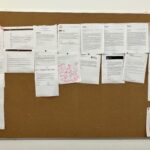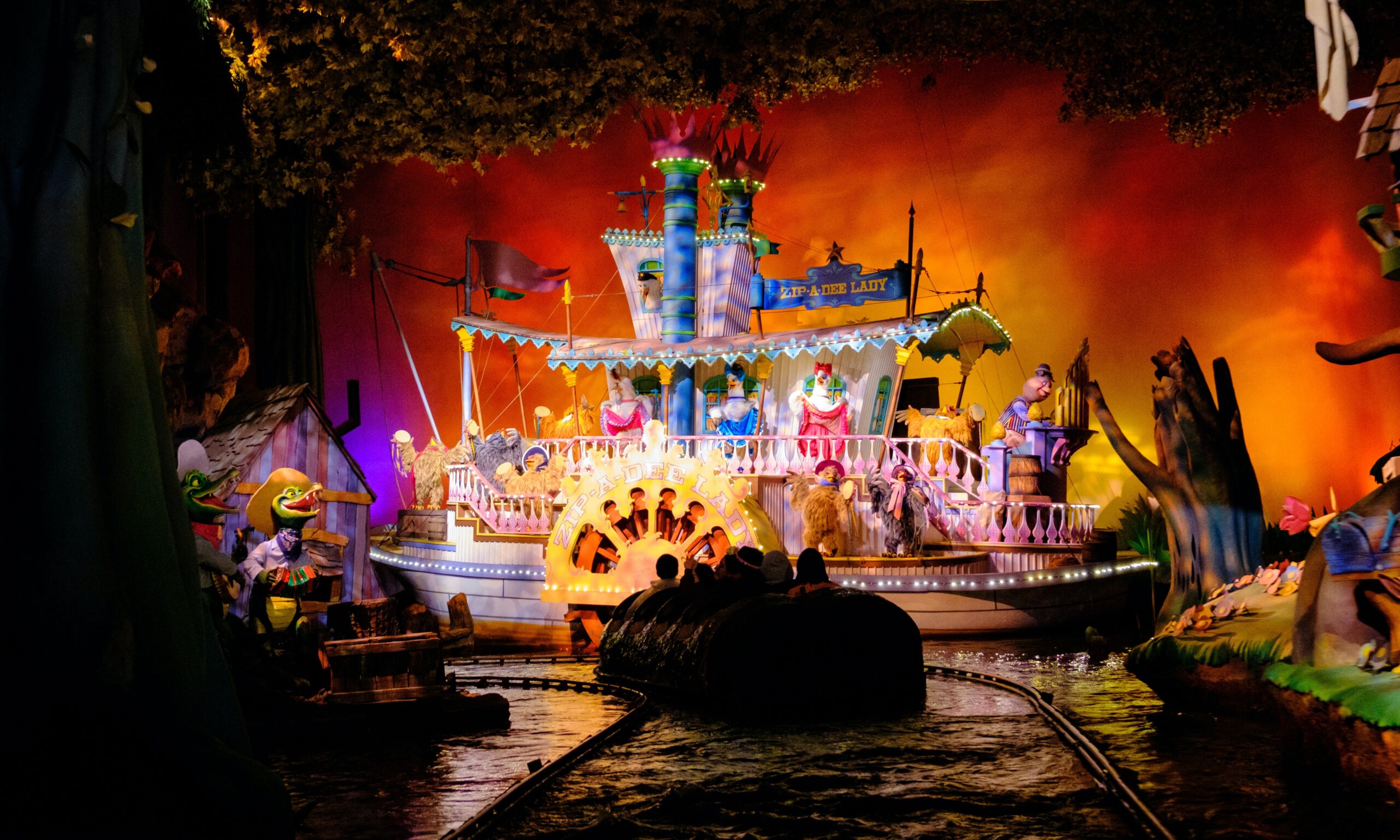Since Disneyland and Disney World’s respective openings in 1955 and 1971, both parks have created a sense of childlike fantasy through curated guest experiences. Visitors have the chance to walk through Sleeping Beauty’s castle and travel into the future in Tomorrowland while ignoring the world outside of the parks’ walls. At the same time, public dissent and efforts to confront institutionalized systems of oppression raise new questions regarding the Walt Disney Corporation’s responsibility to purposefully contend with colonial legacies and connect the parks to reality.
According to the Main Street Opera House at Disneyland, Walt Disney’s initial inspiration for Disneyland came from watching his daughters on Griffith Park’s merry-go-round in Los Angeles. “I’d sit on a bench eating peanuts, and I felt that there should be… some kind of amusement enterprise built where the parents and the children could have fun together,” Disney said.
Disney’s idea eventually developed into twelve ever-popular amusement parks, spanning four countries and three continents. Millions of people travel and pay an average of $150 in admission fees a day to visit a Disney park, and they have garnered unprecedented success as some of the most visited theme parks in the world.
Fulfilling Disney’s original wish, Lick-Wilmerding High School park-goers largely attribute their present love for the Disney parks to their fond childhood memories. With reminiscent smiles on their faces, some students recalled stories of their favorite rides. “During the parade, all of the lines are super short because everyone’s watching [it] so we would go on [Pirates of the Caribbean] back to back and I remember being so happy,” Olivia Castillo ’23 said.
Others appreciated the attention to detail that Imagineers, the designers of Disney’s parks, put into every aspect of the Disney experience, from attractions to Main Street’s buildings. Ella Schwartz ’24 described the parks as “magical,” truly embodying the Disney parks slogan, “Where Dreams Come True.”
For many Disney parks fans, including myself, Disney represents just that: a place where anything is possible with just a dash of pixie dust. However, this belief becomes concerning when visitors are unable to recognize that the Disney parks do not reflect real life and often reflect colonial fantasies instead.
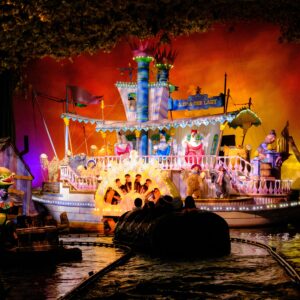
Amid the 2020 Black Lives Matter protests, Disneyland and Disney World led the charge of corporate accountability through the rebranding of their popular log ride, Splash Mountain, which pictured scenes from Disney’s racist movie “Song of the South.” The company’s decision was influenced by a Disney fan’s petition to make the ride “Princess and the Frog” themed. Their appeal received over 21,300 signatures in only a few weeks.
Released in 1946 and condemned by the National Association for the Advancement of Colored People (NAACP) in a public statement, “Song of the South” follows a young white boy who runs away from his family and befriends Uncle Remus and his friend Brer Rabbit.
Both characters were created by writer Joel Chandler Harris and widely popularized in his 1880 collection of short folktales “Uncle Remus, His Songs and His Sayings.” Within the book, Uncle Remus, a recently emancipated elderly Black man, narrates allegorical tales of strength and perseverance to his former enslavers’ young son. However, as a privileged white man, the author’s representations of Uncle Remus and Brer Rabbit cast them as racial caricatures, evidenced by Harris’s use of Black vernacular which stereotypes both characters as ignorant.
Although the film was widely successful at the box office and received an Academy Award for the original song “Zip-a-Dee-Doo-Dah,” many critiqued its representation of Black Americans who appeared to miss their plantation lives post-emancipation. Less than a month following its release, the Theatre Chapter of the National Negro Congress picketed New York’s Palace Theater in protest of the Disney production company’s depiction of Black Southerners.
Currently, “Song of the South” remains unavailable to viewers since the Walt Disney Corporation withdrew the movie musical worldwide in 2001.
Even though news of the incoming “Princess and the Frog” ride in Splash Mountain’s place brings many fans joy, others have expressed sorrow and frustration at the company for remodeling a beloved childhood ride. Since the ride’s removal at Disney World on January 23rd, reactions from superfans online have ranged from posting tribute videos on social media to buying plastic bags of the rides’ water on Ebay. One fan even remarked that the ride’s rebranding would replace the attraction with the film’s components of “voodoo” and “black magic,” insinuating that this is worse than the originally racist elements.
For these fans, Disney’s step towards a more equitable future means having parts of their childhood ripped away, pushing them to steadfastly hold on.
Although Disney had been privately discussing possible plans to overhaul Splash Mountain since 2015, the public outrage from fans largely contributed to the accelerated timeline. As the people who ensure the parks are routinely visited and that Disney’s profits rise, fans hold extreme influence over company decisions, which they are not afraid to wield.
“Corporations fundamentally exist for one basic thing, and that is to keep profits coming in. So, if anything threatens the profits of corporations, that’s when they act,” LWHS Modern World History Teacher, René Villicaña, said.
For Disney, their ride controversy created the possibility of revenue loss which spurred immediate action to appease fans. However, there are many other aspects of the Disney parks that perpetuate harmful racial stereotypes that fans fail to recognize and hold the company accountable for.
Opened in 1982, Epcot’s World Showcase in Disney World includes Disney’s interpretations of nine countries ranging from Mexico to China to Morocco, all relying upon surface level (and often inaccurate) understandings of each nation in order to create an enjoyable experience for guests.
On a recent visit to Disney World in December, I watched as countless fans wandered around the Showcase — a breeding ground for cultural appropriation and fetishization — without applying a critical lens.
While making my way through the Showcase and Disney’s curated pockets of the world, I felt as if I was walking inside a travel brochure. Those around me marveled at scaled-down recreations of the Eiffel Tower and a 7th Century pagoda in “France” and “Japan” like they had somehow been transported from Orlando, Florida to the countries they were “visiting.”
If the World Showcase was a travel brochure enticing Americans to explore the globe, then my fellow park visitors were tourists. Just like tourists, they contributed to the faux local cultures by donning bamboo hats from “China,” which they wore even while crossing borders into different countries. Or by buying wood carvings from the Village Traders’ “Africa”-themed outpost, which is included in the country Showcase even though Africa is in fact a continent.
However, the Showcase also allowed park-goers to return to the states, traveling through Disney’s idyllic America decked out with the flag’s stars and stripes and patriotism heavy in the air.
Along with the available food and merchandise, the America pavilion is best known for the American Adventure, an attraction which the Walt Disney website promotes will make visitors “feel the spirit that propelled America to greatness in an inspiring retelling of our nation’s history.” The show features 35 audio-animatronic figures of important names from our history books like Frederick Douglas and Susan B. Anthony, digitally projected images and supposedly “patriotic songs.”
Despite Disney’s marketing of the attraction as educational and true to the nation’s history, it instead promotes a simplistic idea of America’s founding which
largely erases stories from BIPOC and other marginalized communities.
After watching the show two years ago on her first trip to Disney World, Castillo described the American Adventure as “a eurocentric idea of what America [is],” a realization that not all Disney fans are able to come to. For some of those visitors who would prefer ignorance over genuine analysis of the nation’s founding narrative, they resort to anger once their exceptionalist view of America is challenged.
Castillo remarked that one guest told her friend and their family that they were uneducated and that the show displayed the “real America” once he overheard them express their frustration at the attraction’s oppressive messaging. His actions show a larger culture of misinformation and misrepresentation that Disney upholds for the sake of satisfying fans who wish that their outlooks remain unopposed.
Guests who would like to continue their Disney world tours outside of Epcot’s Showcase can buy tickets to visit Animal Kingdom where the “Asia” and “Africa” parks reside.
Apparent from the moment visitors step into the park, Disney intentionally brands Africa as a monolith rather than a continent encompassing 54 countries with vastly unique civilizations. Within the walls of Animal Kingdom, Africa becomes a singular deindustrialized nation, existing solely in the jungle with straw huts and dirt-stained buildings.
Disney’s Imagineers modeled the architecture after buildings they saw while visiting the continent on a research trip to help them build an accurate park back in Orlando. Yet, it’s clear to any visitor who critically evaluates the park and understands colonialism’s impact upon Africa that there is nothing authentic about this depiction, no matter the intentions that Disney may have had.
By choosing their favorite parts of each country to represent, pulling from Tanzania, South Africa and Kenya, Disney created a hodge-podge of African culture which makes gleaning any accurate information impossible.
“Asia’s” Anandapur suffers from a similar fate of damaging representations as exhibited by the scuffs and posters on each building in the park, deliberately framing it in destitute. Rather than being characterized as a safari like Africa, Disney portrays Asia as a haven for explorers, and even provides eager masses the opportunity to “climb” Mount Everest in the Expedition Everest ride. Borrowing from random Asian countries like Nepal, Mongolia, Indonesia and India, Anandapur examines the continent through the lens of the colonizer who only values the parts of Asia that they can benefit from.
Through their popular theme parks, Disney offers fans a fantasy world where they can enter a passive state and become numb to the oppressive structures which exist around them as part of the parks’ foundations. “We go to those places to forget the world that we’re in and with that leisure comes this relaxation of consciousness,” Villicaña said.
Ultimately, Disney is aware that they do not have the facilities to properly represent the globe, but their careless solution of creating singular narratives is misleading for guests and perpetuates harmful stereotypes. Through parks like the World Showcase, Asia and Africa, Disney maintains creative control over public perception of these places and fans’ realities remain unshattered, keeping both groups uneducated.
In order to truly usher the Walt Disney Corporation and all that it encompasses into a more equitable future, it is up to the guests to free themselves from the magic and ground themselves in reality, no matter what they may be forced to leave behind.
